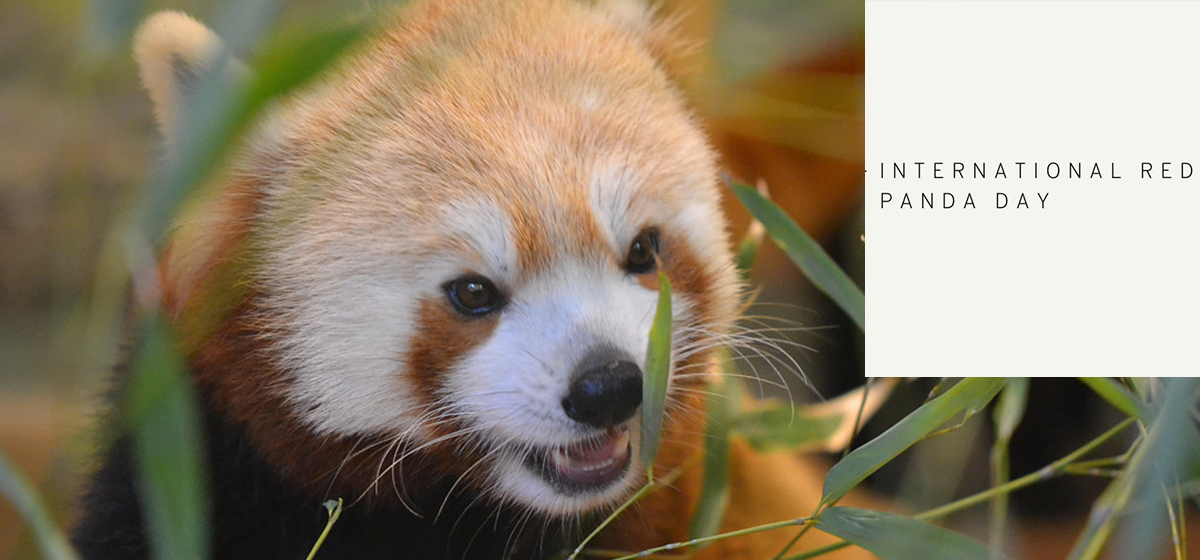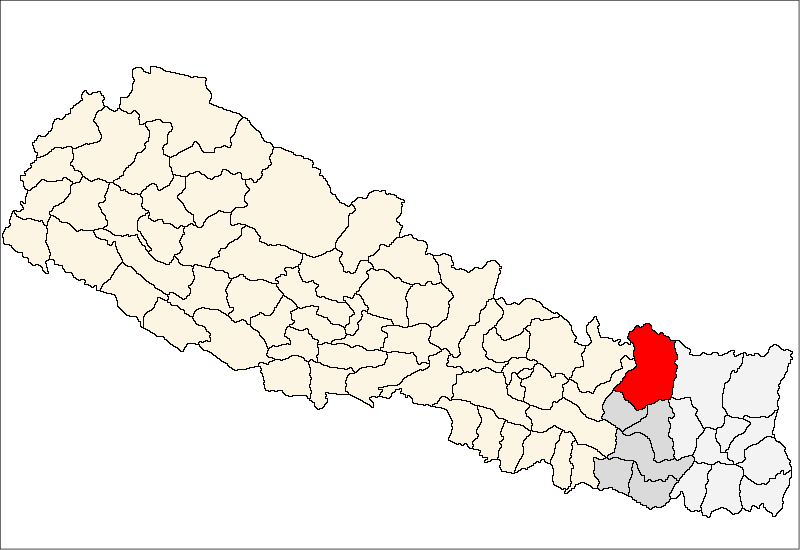
OR
International Red Panda Day

In Nepal, the red panda is listed as a nationally-protected species under the National Parks and Wildlife Conservation Act 1973 AD. There are around 1,000 red pandas in Nepal according to the National Red Panda Census of 2016, distributed both inside and outside protected areas.
Do you know that the red panda is the first panda? After hearing this, you will definitely ask: what about the giant panda? But many of us don’t know that the red pandas were discovered 50 years before the giant pandas and thus, named ‘panda’ first.
Even though their physiology is similar to carnivores, both pandas are herbivorous in nature. While a giant panda’s diet is entirely plant-based, the red panda sometimes consumes fruits, berries, bird eggs, insects and even small birds beside the bamboo shoots and leaves which accounts for 97 percent of its diet. So, red pandas are often called opportunistic eaters.
Meanwhile, the word ‘panda’ is believed to be derived from the Nepali word ‘nigalya ponya’ which simply means the ‘bamboo eater’. And despite having ‘panda’ in their names, these two are not related to each other.
Red pandas are an extant species from the family Ailuridae, i.e., there are no any other species besides it in the Ailuridae family. Whereas many studies suggest that there are two subspecies namely the Himalayan red panda (Ailurus fulgens fulgens) found in Nepal, India, Bhutan, Myanmar, China’s Yunnan province, and the Chinese red panda (Ailurus fulgens styani) found in Myanmar and different provinces of China.
The red panda is a shy, solitary, elusive and arboreal animal with a body size similar to that of a domestic cat. This unique animal has a tail length equal to its body length. Its copper-colored/reddish-orange tint of coat provides good camouflage in the environment of a temperate broad-leaf forest. Because of this vibrant color, it is also nicknamed as the ‘firefox’. And since 2004, it has been the mascot of Mozilla Firefox Internet Explorer. This helped to bring red pandas into the mainstream public eyes as they were not widely known until then. Unfortunately, this was not enough to induce the much-needed conservation attention. They only started to get global attention much later after 2010.
At present the red panda is classified as an endangered species with a decreasing population by the IUCN Red List which shows the worrisome global conservation status as it lies in an abyss of multiple threats. In Nepal, red panda is listed as a nationally-protected species under the National Parks and Wildlife Conservation Act 1973 AD. There are around 1000 individuals as per the National Red Panda Survey of 2016 which are distributed both inside and outside protected areas. However, they face multiple threats like habitat loss, fragmentation, deforestation, road construction, forest fires, loss of the bamboo forests, poaching, unintentional falling into traps/snares meant for other animals, attacks by wild animals and feral dogs, transmission of gastrointestinal diseases from herder’s dogs and cattles along with inadequate conservation concern. And many ethnozoological uses and beliefs of red panda have further amplified the threats. For example, claws to treat epilepsy, fur used in rituals by shamans, pelts as scarecrows in farmlands etc. where its hides is one of the most confiscated wildlife parts in Nepal (See. Bista, Baxter & Murray, 2020).
Being an endangered extant species, it is amazing that it has subspecies. But because of it they have their fair share of misfortunes. Its global population is said to be fewer than 10,000 with wild numbers as few as 2,500 (See. Red Panda Network, 2021). It is of critical importance because its global number which is already low and declining, when divided between the two subspecies the number of each subspecies will be much smaller. These further additionally highlight the possible risks of less genetic variation due to interbreeding and inbreeding where interbreeding results in sterile male offspring and inbreeding results in the birth of offspring with increased risk of health disorders. Clearly its healthy genetic status is hindered where genetic diversity is crucial for its future existence.
Also, because of their cutesy appearance, live red pandas are often smuggled in black market for the pet trade. But the majority of people are unaware that they have very sharp claws to climb trees and when they get slightly aggressive these claws can cause mild to severe bruises on skin. Thus, a red panda is a bad option for a pet.
Moreover, it has an average lifespan of eight years in the wild and usually gives birth to a litter of two cubs in a year after reaching reproductive age of 18 months. And there is a low chance of those offspring surviving in the wild because of the above-mentioned threats coupled with the low birth rate. This gravely pushes this species into the huge risk of extinction.
The giant pandas are no longer listed as endangered species. This was due to extensive conservation efforts employed for their habitat protection, ex-situ conservation (e.g., captive breeding), awareness in global citizens about its conservation etc. Also, the giant pandas got a considerable share of conservation recognition worldwide though they were discovered later than the red pandas.
So, it is high time to address the conservation concerns regarding red pandas where we need to minimize these threats and carry out conservation actions which help to recover their wild numbers. Foremost, we should protect their remaining habitats and minimize our activities which destroy, degrade and fragment their existing habitats. We also need to closely inspect other activities which impact them directly. For example, morbidity and mortality due to gastrointestinal diseases. Cattle herding inside its habitats is one of the major routes for transmission of endoparasites, so the existing herding practices should be managed (See. Bista et al., 2017).
Another main hindrance to achieve red pandas’ conservation goals is the lack of awareness. Its conservation status, importance along with its mere existence from the family Ailuridae should be shared and celebrated broadly. And conservation awareness about its conservation status along wildlife laws and enforcement should be endorsed widely to demotivate people from illegal poaching and trafficking. If a red panda is killed, poached, possessed, transported or illegally traded, one gets a hefty penalty of up to one million rupees or up to 15 years of imprisonment or both, according to the National Parks and Wildlife Conservation Act 1973. Along with that the confusion regarding species classification and distribution should be quickly addressed.
Therefore, addressing the conservation threats for red pandas’ long-term survival is very important. It is our duty to conserve this endangered species and if we won’t, then the very last species of the Ailuridae family will be wiped out from earth.
(The author is associated with Greenhood Nepal and leads the Rufford Foundation-funded research of implementing conservation education about the Red Panda and analysing its effectiveness.)
You May Like This

Federalism: learning by doing
Issues have emerged regarding effective implementation of federalism. But there is a long way to go and these issues can... Read More...

Aug 21: 6 things to know by 6 PM
Your daily dose of missed important news of the day. ... Read More...

What Nepal needs is India's friendship and support for growth: Nepal PM Oli
In an exclusive interview to The Hindu, Mr. Oli says the bitterness of past relations have been put behind them,... Read More...





Just In
- Govt to provide up to Rs 500,000 for building houses affected by natural calamities
- China announces implementation of free visa for Nepali citizens
- NEPSE gains 14.33 points, while daily turnover inclines to Rs 2.68 billion
- Tourists suffer after flight disruption due to adverse weather in Solukhumbu district
- Vote count update: NC maintains lead in Ilam-2
- NAC's plane lands at TIA after its maintenance in Israel
- Indian Ambassador assures of promoting India's investment in Nepal
- Freak accident involving self-made pistol leaves young man injured in Banke















Leave A Comment